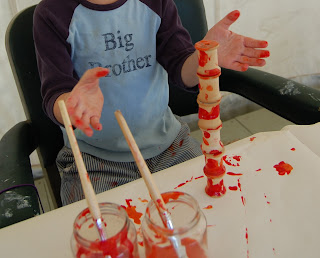
The wait is over. On Friday the 13th Kirk came over with a box of angry bees and our adventure in beekeeping (
backwards) began. The bees had been split from another hive by Kirk and Sebastian. They are not queen right (no laying queen) but have 2 queen cells and should be right in about a week. When bees don't have a queen, they aren't particularly happy campers. Nor do they appreciate being shut in, jostled or having their hive moved for them - understandably so.

Kirk got our medium boxes ready for the 5 large frames the bees were on by stacking our medium boxes two deep and removing 5 frames from both the upper and lower boxes. The deeper large frames will hang down from the top box into the lower one - not really how they were meant to work but it gets the job done and that's how we roll at Camp Ramshackle.

We suited up while Julia and the kids watched.
This is probably the right time to mention that I don't really have a proper beekeeping suit - its just a hat, veil and tough silver members-only-style jacket that I got from work as a holiday gift and never wore. I think I was lulled into a false sense of security after watching "
Every Third Bite" (about 5 times) and seeing the beekeepers there with no equipment on at all.

As Kirk carried the
nuc up to the hive site quite a few bees slipped out the cracks. They weren't in the best mood and forced Julia and the boys into the house. That left me the job of taking pictures which is not the easiest thing to do when you have a makeshift bee suit on.
Kirk smoked the
nuc twice. I was a little surprised by the defensive behavior of the bees when he opened the lid. About 10 or so workers immediately flew to the camera and began trying to sting it and my gloved hands. I think they may have mistaken the black lens for a bear snout. I have to admit a moment of doubt in my shoddy beekeeping suit's efficacy but it held up perfectly.
In the
picture above you can see the bees dangling from the starter strip on this frame. Kirk said that's what they do when they are getting ready to draw the comb.

Here Kirk is pointing out the queen cells.

Close-up of the queen cells.

A full brood frame goes in. After that the stragglers were dumped from the
nuc to the top of the hive and it was closed up. Kirk and I went back inside for some water and home made coconut macaroons while I got some more instruction on feeding which will be in the next post. I also uploaded
more pictures here on our flickr account.

A few hours later, after the air had cleared of bees I went to get the camera which I had left near the hive. I snuck around the corner to snap a picture when a handful of guards spotted me and chased me off.
Over all it was a complete thrill and I am happy to say that no one was stung (except possibly our dog
Trudy - but if she was, 5 minutes later you couldn't tell) Thanks Kirk!
Previously:
All of our posts about BeesRelated:
more pictures on flickrBackwards Beekeepers Blog

 He told me how you can grow sugar cane from cuttings just like bamboo. Where the joints form sprouts emerge. Just cut a sprouting section and put it in the dirt.
He told me how you can grow sugar cane from cuttings just like bamboo. Where the joints form sprouts emerge. Just cut a sprouting section and put it in the dirt. We put two cuttings in some plastic pots to get them going with just the tips of the sprouts above ground.
We put two cuttings in some plastic pots to get them going with just the tips of the sprouts above ground.
















































